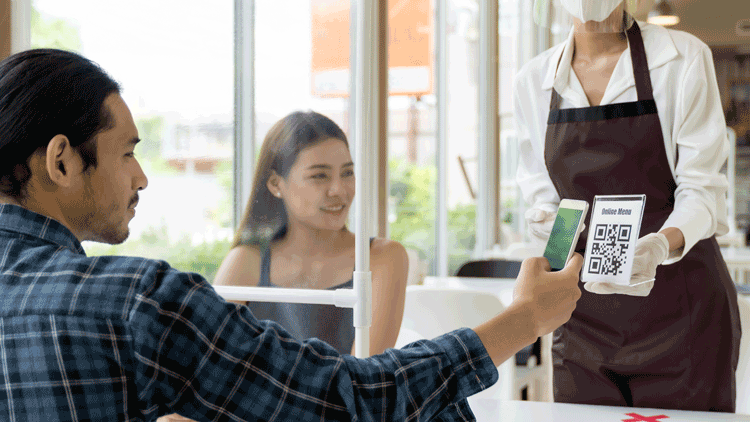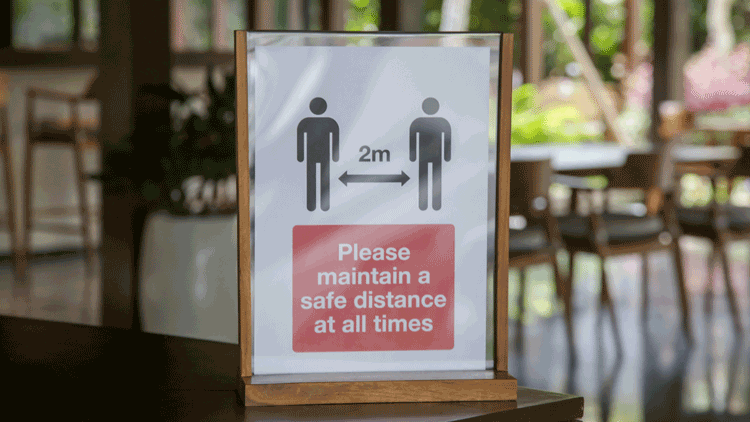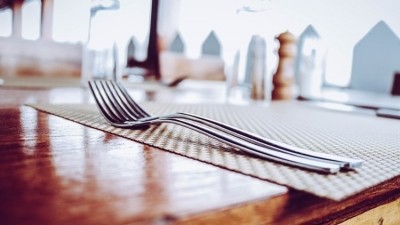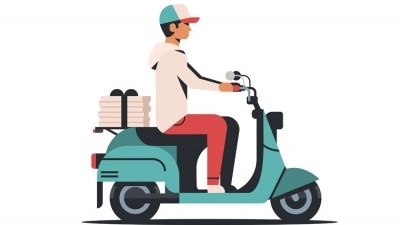Sponsored by Goodtill
Back to business: how to reopen on the front foot
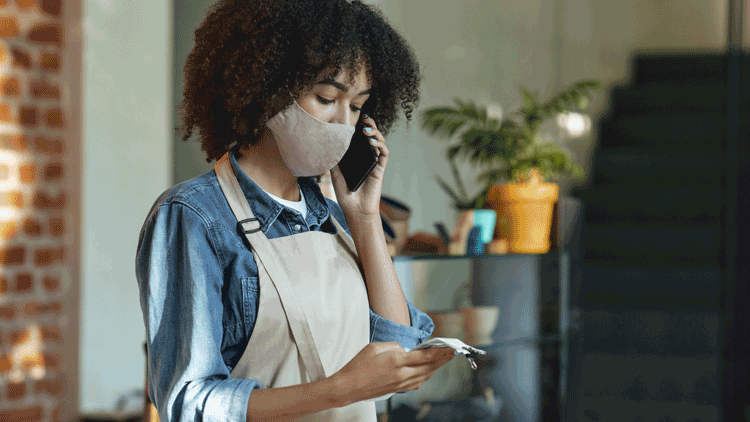
Streamline menus and keep competitive
With the uncertainty of al fresco dining due to changeable weather conditions and the reduced numbers of covers that businesses can do, many businesses will not be operating with full teams when they do choose to reopen, so ensuring that your operation reflects this is crucial.
One way to do this is through the streamlining of menus to ensure that kitchen teams can cope in the early stages and to keep ordering and overheads costs as low as possible to reduce waste should adverse weather hit. Gastropub Parkers Arms in Newton-In-Bowland, for example, has reopened its doors for al fresco trading with a tight picnic box menu that features dishes including a home-smoked peppered brisket bun with skinny fries; a Whitby lobster roll; a wild garlic, spinach, Lancashire cheese and hen’s egg pie; and Lebanese style spiced minced lamb on sourdough flatbreads, with many of its more involved dishes on hold for the time being.
Phil Howard, chef-patron at Michelin-starred Chelsea restaurant Elystan Street, also advocates a less is more approach in the days after reopening. Elystan Street won’t reopen until after 17 May and when it does it will have a menu reflective of the current trading environment.
“For restaurants to succeed they need to be as streamlined as possible so if anything, we will reopen with an as disciplined approach to the menu as possible,” he says. “We will open with a menu that is our most competitively priced – that doesn’t mean I’m going to take a hit on the margins but I’m not going to put turbot on the menu but instead keep it as accessible as possible.”
Any streamlining shouldn’t be at the expense of the restaurant’s ethos, however. “A lot of people will be going back to their favourite restaurants because they are what they are - our intention is to open with a menu of crowd-pleasing dishes. There is logic in giving people the exact experience that they previously had.”
Think speed, safety, efficiency
Restaurants and pubs reopening need to make the customer journey as safe and as pain-free as possible, and this is where technology can play an important part.
Mobile ordering and payment options that enable customers to order food and drink from their table via their smartphones by simply scanning a QR code can play a significant role in reducing unnecessary contact between staff and customers and helping to reduce and potential spread of infection.
“One of the key things we are seeing from prospective and current customers is that they have got to be taking advantage of table ordering software,” says Oliver Rowbory, director at iPad POS provider Goodtill by SumUp.
“With a decent table ordering provider the customer can actually chose what they would like to eat and drink and pay for it at the same time using their smartphone and haven’t had to touch anything else. They don’t have to retouch menus but simply scan a QR code on the table.”
Rowbory says that whichever tech provider a business uses, they should look for ease of use and the ability for it to be integrated easily into an existing PoS system.
“The technology has to be very simple because you’re going to have a range of ages and technical ability using it,” he says. “And if your PoS system and table ordering systems are one and the same then there is only one company to deal with, one support team, and no orders will go missing.
“Your reopening checklist should be to find a decent reliable provider that has a good reputation for setting up and ongoing support.”
Rowbory says that while there had been reluctance among some businesses to adopt mobile ordering and payment technology pre pandemic, uptake of such systems has been high since the lifting of the first lockdown last summer. Moreover, businesses and customers have reacted positively to the move.
Lumina Intelligence’s The Role of Technology in Hospitality report recently found that 55% of restaurant goers either agree or strongly agree that they feel more confident going to a restaurant that has implemented technologies such as apps and QR codes to limit the contact needed to have with menus and staff.
“There has been a real step change in people adopting new technology,” says Rowbory. “Businesses that were reluctant to adopt tech have seen other businesses around them thrive.
“From a consumer perspective we’ve seen reluctance dissipate in people using their smartphones - they’ve seen how easy it is to order what they want when they want.”
Pub group Greene King recently reported that usage levels of its order app had soared since reopening, with 70% of orders being submitted by guests through the technology.
Mitchells & Butlers (M&B) also believes that the use of technology such as order and pay at table apps are here to stay. Speaking to BigHospitality’s sister title MCA, M&B chief executive Phil Urban said that order and pay at table has also helped raised average spend at the pub group.
“One of the things we are seeing is spend per head go up when they (customers) used those apps as it becomes very easy to order. One of the few benefits of the last year is it’s probably accelerated the adoption of those things by at least 12 months.”
For those businesses yet to reopen again, Rowbory advises that they do some checks with their mobile ordering systems in advance of throwing open the doors.
“Do this now. Look at what technology you are going to be using and don’t assume that just because you used it last year you can literally turn it on at 10am and it’s going to work perfectly. Test it well in advance that it still works, ensure new menus are uploaded, do some test transactions - we’ve heard of some businesses that have dusted it off and there have been issues.”
Be flexible
Uncertainty about trading levels and the number of people that will be willing to return to restaurants means that businesses should also try to be as flexible as possible.
Dan Kenny, founder of The Set in Brighton, recently closed his restaurant in the city’s Artist Residence hotel and moved the business into Café Rust as part of a partnership. The move means the business will hopefully be less exposed in the event of another lockdown.
The relocated The Set will be there for at least a year, according to Kenny, with the option to increase the number of nights it opens. “After the last 12 months we’re sceptical and cautious,” he says. “Low risk is good. It’s a nice partnership that works well for both us and Café Rust.”
Kenny believes that more businesses like his might follow suit to collectively help the hospitality sector get back on its feet. “I’d be surprised if we don’t see a lot more restaurants and chefs go down this route. Multiple businesses sharing one space makes a lot of sense. It’s a good way to rebound. Like everyone we’ve lost a lot of money over the last year.”
At the soon to open Eataly in London’s Liverpool Street, the owners have also designed flexibility into the model to be able to manage with social distancing restrictions and make customers feel as comfortable as possible while navigating its retail and restaurant areas.
Despite restrictions forcing Eataly to keep all of its indoor dining areas closed for the first two weeks of its opening, the team is confident about still being able to deliver a memorable experience to customers.
“Our focus is on keeping our customers and our team safe, while also working really hard to try and still give people the full Eataly experience. We may not be able to do tastings, but we are able to talk to people, show them what we’re doing, and still give people a really good insight into what we offer,” says marketing and communications manager Lucy Chase-Gardener.
“There’s things we’ve had to adapt and change, but we’ve taking a very flexible approach to achieving that.”
Use the customer data
An additional benefit beyond speed of service is the capturing of customer data by order and pay systems that businesses can use for marketing purposes.
“By customers using this kind of table ordering software [businesses] are getting a lot more data and information on who their customer are, whether are returning ones or not, what they like to eat and drink, and when they like to eat and drink it,” says Rowbory.
“Then they can build up a nice customer profile, all GDPR compliant, and then target them with relevant offers.”
Research suggests that customers themselves are happy to be sent targeted deals, such as free drinks and money off vouchers. According to Lumina Intelligence research, 60% of consumers are willing to received personalised food offers based on their previous experiences.
Goodtill says it can help businesses bolster their customer base with its loyalty module. Its Goodies app is a loyalty iOS application that allows businesses to create and communicate promotions, points-based loyalty programs and offers to their customers via their smartphones. Its loyalty app allows hospitality businesses to give their customers the ability to record sales via a QR code and sign up to recall details, track and redeem points.
Businesses can customise the Goodies app to represent their brand, with the option of adding an app name, logo and customising the colour scheme enabling them to market themselves at very little extra effort.
“Digital systems give businesses the ability to communicate and engage with customers as never before. Through an app or email address or even through social media they can offer promotions to increase footfall in dead hours,” adds Rowbory. “Businesses have opened their eyes to the fact that they have a more direct link to their customers than ever before and that consumers are more open to receiving promotions.”
Consider a subscription model
With levels of trade likely to be hard to predict beyond the initial first flurry following the complete lifting of lockdown, some restaurants and groups have been looking at ways to try and create a more regular, guaranteed form of income.
Pret a Manger was one of the first to take this approach when last year it launched its YourPret Barista coffee subscription where customers can get up to five ‘barista-prepared’ drinks each day for a fixed monthly price of £20. Since then, companies such as Leon have followed suit, with the healthy fast food company offering 30% off all of its vegan dishes, drinks, coffees and cakes for £6 a month.
Wine and cheese shop Provisions in north London recently launched a nationwide monthly wine subscription of a case of six different wines and upmarket coffee group Watch House Coffee also has a subscription model for people that want to enjoy its coffee at home. It says it looking at a similar model for its in-store customers.
“We want to go one step further with non-fungible tokens,” says founder Roland Horne. “The basic principle is that you can create tokens that customers can exchange for goods and services from us, thereby cutting out the middleman and giving us a closer connection with them.
“Each token is unique to that customer, meaning that loyalty can be easily tracked and managed. For example, we can give people tokens that can only be used within a certain period. Customers are also able to trade tokens if they want.”
Give people space
Hospitality venues have proven to be very good at creating safe environments and despite the UK’s successful vaccine rollout programme many customers will need reassurance that the venues in which they are eating and drinking are as safe as possible.
M&B’s Urban foresees customers expecting the same standards of safety, including things like sanitising stations, and more space around tables, even once restrictions have been fully lifted.
“As an industry we have to think about that,” he said. “One of the negative by-products of all this is that our government has planted a seed in the guests’ minds that somehow hospitality is a bed of infection, so we have to work hard to demonstrate that we are not.”
As well as ensuring tables are spaced well apart and that staff are wearing masks restaurants should consider using signage to make the guest experience as simple as possible, advises Rowbory.
“It’s important that there is decent signage within the venue, so whether it’s a host on the front door, table talkers or signs around the building, telling people this is how you order and pay so you can avoid unnecessary contact.”
Martin Williams, CEO at Rare Restaurants, which owns the Gaucho and M restaurant brands, says customers were well versed with the hygiene protocols when he reopened some of his venues for outside trading from 12 April.
“After living with Covid and the restrictions brought on by it for more than a year now people have become accustomed to the minor but necessary inconveniences caused by the precautions we have had to put in place to keep our guests and teams safe.
“Our guests seemed very comfortable and satisfied (in some cases even well practiced) with the request to sanitise their hands on arrival, spacing between tables, and our teams wearing masks and wiping down surfaces regularly. In Piccadilly, one older couple commented to reception on the way out after lunch how organised the restaurant felt today.”
Gaucho and M invested £100,000 in weatherproofing and heating its terraces and the group has so far reported strong trading at its venues. On the first day that lockdown lifted Gaucho sold more than 1,000 bottles of Malbec and over half a ton of steak, which it says is almost one kilogram per cover available. It also anticipates that strong al fresco trading will continue until 17 May.
Eataly is equally bullish about its prospects, and reports that its terrace is already fully booked for the first two weeks.
“Eataly is such a destination that we’re confident we’ll have high traffic, regardless of the levels of footfall on the high street,” says Chase-Gardener.
“We’ve had amazing response since we opened our bookings, and there’s a huge appetite from people to go out. And I think we’re ready for that.”
